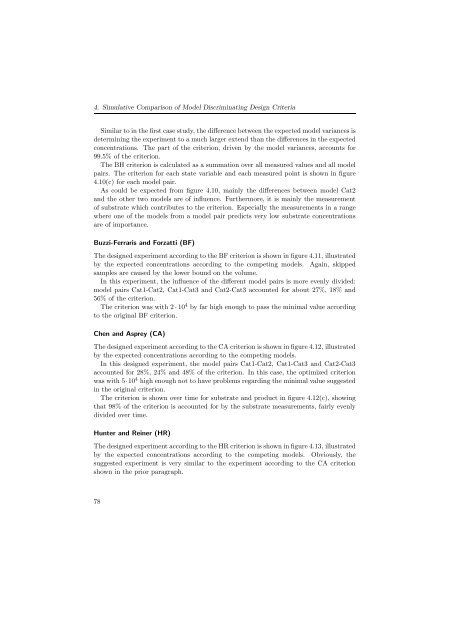Corynebacterium glutamicum - JUWEL - Forschungszentrum Jülich
Corynebacterium glutamicum - JUWEL - Forschungszentrum Jülich
Corynebacterium glutamicum - JUWEL - Forschungszentrum Jülich
Create successful ePaper yourself
Turn your PDF publications into a flip-book with our unique Google optimized e-Paper software.
4. Simulative Comparison of Model Discriminating Design Criteria<br />
Similar to in the first case study, the difference between the expected model variances is<br />
determining the experiment to a much larger extend than the differences in the expected<br />
concentrations. The part of the criterion, driven by the model variances, accounts for<br />
99.5% of the criterion.<br />
The BH criterion is calculated as a summation over all measured values and all model<br />
pairs. The criterion for each state variable and each measured point is shown in figure<br />
4.10(c) for each model pair.<br />
As could be expected from figure 4.10, mainly the differences between model Cat2<br />
and the other two models are of influence. Furthermore, it is mainly the measurement<br />
of substrate which contributes to the criterion. Especially the measurements in a range<br />
where one of the models from a model pair predicts very low substrate concentrations<br />
are of importance.<br />
Buzzi-Ferraris and Forzatti (BF)<br />
The designed experiment according to the BF criterion is shown in figure 4.11, illustrated<br />
by the expected concentrations according to the competing models. Again, skipped<br />
samples are caused by the lower bound on the volume.<br />
In this experiment, the influence of the different model pairs is more evenly divided:<br />
model pairs Cat1-Cat2, Cat1-Cat3 and Cat2-Cat3 accounted for about 27%, 18% and<br />
56% of the criterion.<br />
The criterion was with 2 · 10 4 by far high enough to pass the minimal value according<br />
to the original BF criterion.<br />
Chen and Asprey (CA)<br />
The designed experiment according to the CA criterion is shown in figure 4.12, illustrated<br />
by the expected concentrations according to the competing models.<br />
In this designed experiment, the model pairs Cat1-Cat2, Cat1-Cat3 and Cat2-Cat3<br />
accounted for 28%, 24% and 48% of the criterion. In this case, the optimized criterion<br />
was with 5·10 4 high enough not to have problems regarding the minimal value suggested<br />
in the original criterion.<br />
The criterion is shown over time for substrate and product in figure 4.12(c), showing<br />
that 98% of the criterion is accounted for by the substrate measurements, fairly evenly<br />
divided over time.<br />
Hunter and Reiner (HR)<br />
The designed experiment according to the HR criterion is shown in figure 4.13, illustrated<br />
by the expected concentrations according to the competing models. Obviously, the<br />
suggested experiment is very similar to the experiment according to the CA criterion<br />
shown in the prior paragraph.<br />
78

















